Visiting Auschwitz-Birkenau, the largest of the Nazi concentration and death camps, is not something to be undertaken lightly. So is it worth visiting Auschwitz?
As I have visited Auschwitz, this is where I can help. Whilst a visit to Auschwitz is informative and a sobering act of remembrance and respect, it can also be emotionally draining.
Here is what to expect from a visit to Auschwitz-Birkenau and how to do it.

Some articles on this website contain affiliate links. This means that I may earn a small commission if you make a purchase through these links. As an Amazon Associate, I earn from qualifying purchases. Read the full disclosure here.
- Auschwitz is 100% worth visiting. In my view, it is the best thing that you can do if you are visiting Kraków or Katowice.
- Opening hours: The Museum is open every day except 1 January, 25 December and Easter Sunday. Check opening hours here.
- Ticket price: Although admission to Auschwitz-Birkenau is free, you have to pay for the guided tour with an educator. In 2024, an English-language tour costs 90 PLN.
Free tickets for Auschwitz without a guide are available for the latter half of the day but these hours are extremely limited during the summer months.
- Advance booking is essential, even for free tickets.
- The cheapest way to get to Auschwitz from Kraków: by bus
- The most convenient way to get to Auschwitz from Kraków: on an organised tour (take a look at this one that I did)
What is It Like to Visit Auschwitz-Birkenau?
After liberation, the original intent was to raze Auschwitz to the ground and, along with it, the evil that had resided there.
However, yielding to overwhelming pressure from its freed prisoners, this decision was reversed. Instead, it has been preserved as a memorial to those who perished there.
The first tour groups were taken around Auschwitz in 1947. Their guides were former prisoners.
Your visit begins at the former Auschwitz I camp and ends in the former Auschwitz II-Birkenau camp.
After passing through security, you then pick up your headset. These earphones mean that your guide doesn’t have to shout and ensure that you don’t miss what he or she has to say, even when they are out of sight.
Visiting Auschwitz I
You enter Auschwitz I under the twisted iron of the “Arbeit Macht Frei” gate – work will set you free. Whilst it has a cruelly symbolic status, only a small proportion of the estimated 1.3 – 1.5 million prisoners who entered the concentration camp passed under this gate.
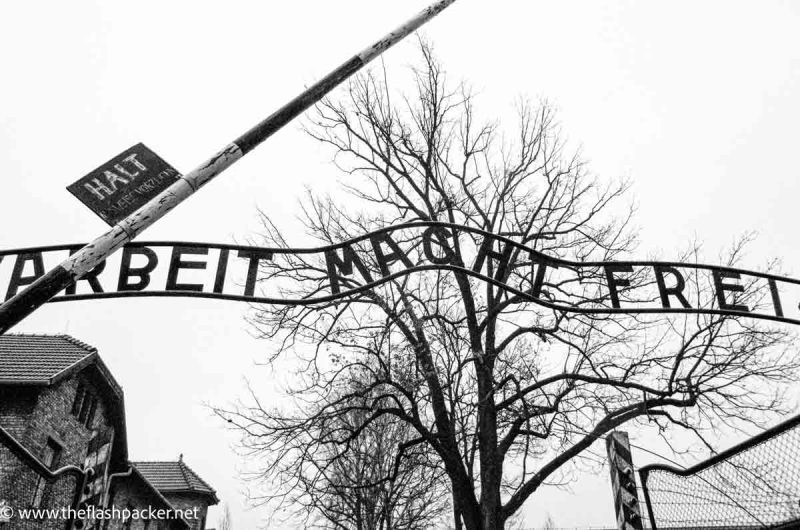
Auschwitz was, in fact, a collection of camps.
Auschwitz I, a former Polish Army barracks, had its first intake of political prisoners in June 1940. However, Hitler’s murderous intent knew no bounds.
In 1941, to increase the camp’s capacity from 30,000 to 100,000, Auschwitz II – Birkenau was built, 3km northwest of Auschwitz I. It was here that the majority of Jewish prisoners died.
Once through this infamous gate, you are greeted with a series of perfectly preserved red-brick barrack buildings, neatly spaced in rows.
Some of these are largely untouched, frozen in time. The remaining buildings house exhibitions displaying 80,000 artefacts remembering the lives lost during the Holocaust.
Block 5 – Material Evidence of Crime
In Block 5 you walk past a case piled high with shoes of every conceivable style, from work boots to flowery summer sandals, the type of fancy footwear that you might wear on a day trip to the beach.
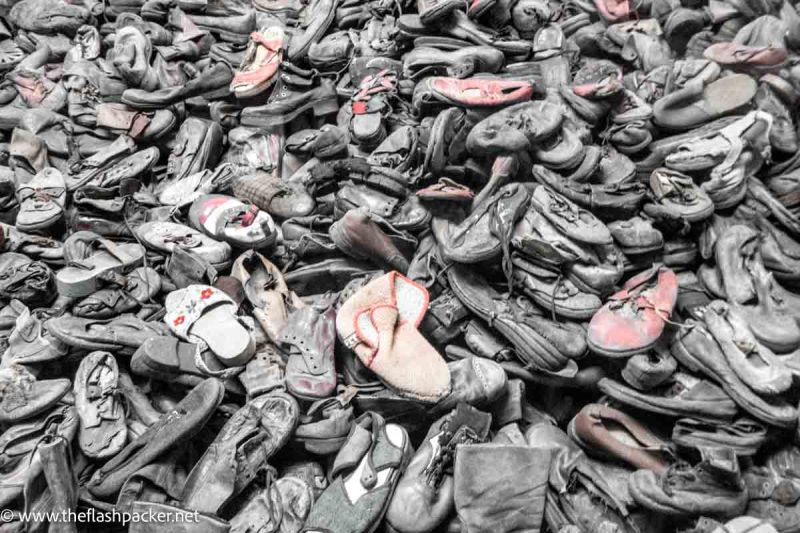
A tangled mass of eyeglasses, weighing a total of 40 kg, peer out at us from another case.
Behind a glass wall running the length of one room are seven tonnes of human hair, shaved from victims before or after death. In life, this mass of hair would have been a spectrum of colours. Over time, it has faded to a uniform dull grey.
Documentary photos show no evidence of distress as Jews awaited transfer to Auschwitz. There is a good reason for this. Unaware of the fate that awaited them, the Jews believed that they were being relocated.
This is evident from other exhibits in Auschwitz’s Museum.
There are hundreds of suitcases, neatly labelled with their owner’s name. Displayed in another case are kitchen utensils, colour-coded in keeping with Kosher law, never again to be used in the preparation of a family meal.
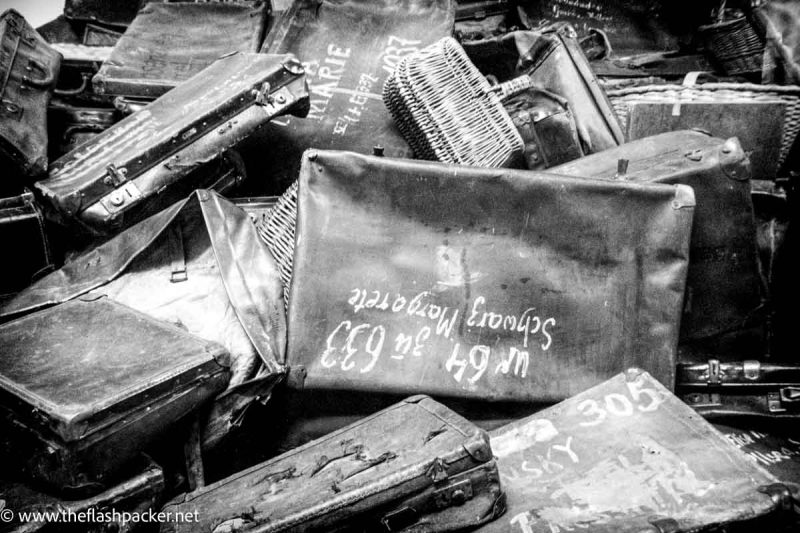
Block 11 – The jail
The infamous Block 11 housed the administrative offices of Auschwitz and was the central jail for prisoners across the camp complex. Here, prisoners were punished and tortured in regular, dark or standing cells.
Standing cells were a particularly cruel form of punishment. Each cell was a space measuring less than one square meter and the only source of air was a 5 square centimetre opening covered by a metal grille. Prisoners could be confined here from one night up to several weeks.
In the courtyard between Block 11 and Block 10 is the so-called Wall of Death. Thousands of prisoners met their fate here, lined up in front of a firing squad.
Roll-call square
Twice a day, at 4.30 am (5.30 am in the winter) and 7 pm, prisoners assembled in Auschwitz’s central ‘square’ for roll-call. They were counted, and if the numbers didn’t tally the roll call would be prolonged. There is one 19-hour roll call on record.
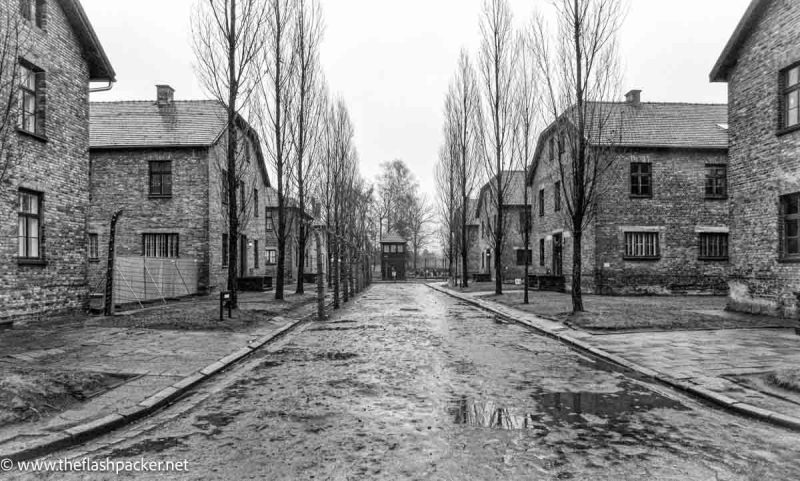
Winters in Poland in the 1940s were harsh and lows of –25 degrees were not unheard of. Many perished during these headcounts.
As the number of prisoners increased, eventually roll-call was conducted in front of individual barracks.
The gas chamber
The remaining gas chamber at Auschwitz is easily the most chilling area of the former concentration camp.
For a truly sobering moment look upwards. Light struggles to peek through the small holes in the roof, into which the Nazis poured deadly Zyklon.
The entire Auschwitz complex had seven gas chambers and five crematoria.
Prior to the liberation of the camp, the Nazis blew most of these up. However, in their haste to destroy any incriminating evidence, this gas chamber was overlooked as it had been converted into an air-raid shelter in 1943.
Documenting arrivals at Auschwitz
However, avoiding the gas chamber was no guarantee of surviving Auschwitz. This is evident from the rows of photographs displayed in the museum.
Until 1942, guards documented an image of each new prisoner. Under each haunting image is the person’s name, nationality or ‘status’ (for example; “Jew”), occupation, date of arrival at Auschwitz and date of death.
For most of these people, there is only a small gap between these two dates.
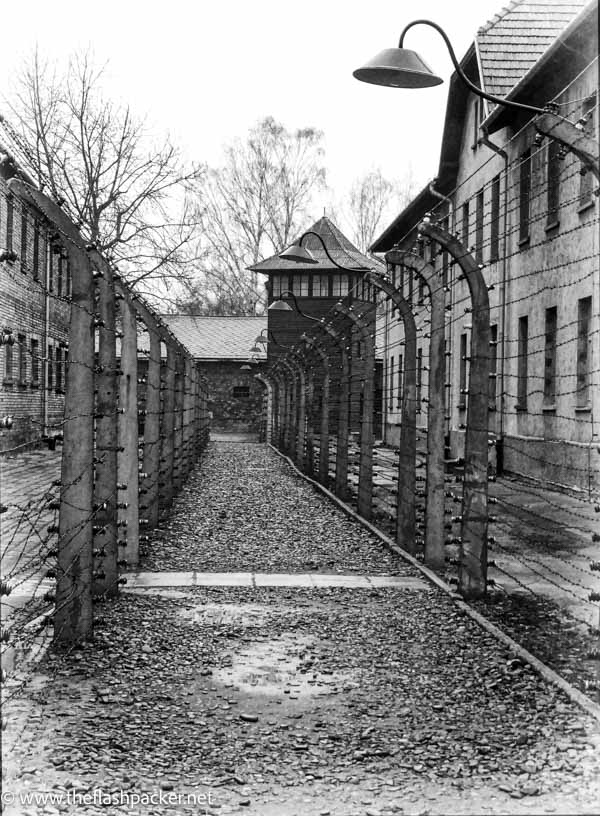
Visiting Auschwitz II – Birkenau
The size of Auschwitz II – Birkenau reveals the scale of Hitler’s murderous ambition. Less of a museum and more of a memorial, Auschwitz II – Birkenau is 20 times the size of Auschwitz I.
The remains of its structures, including its 300 mostly wooden barracks, have been left untouched. These include a pile of rubble that was a gas chamber and Crematorium IV.
Unlike the other crematoria at Auschwitz, this was not blown up by the Nazis. Instead, it was burnt down during a mutiny led by the Sonderkommandos earlier in 1944.
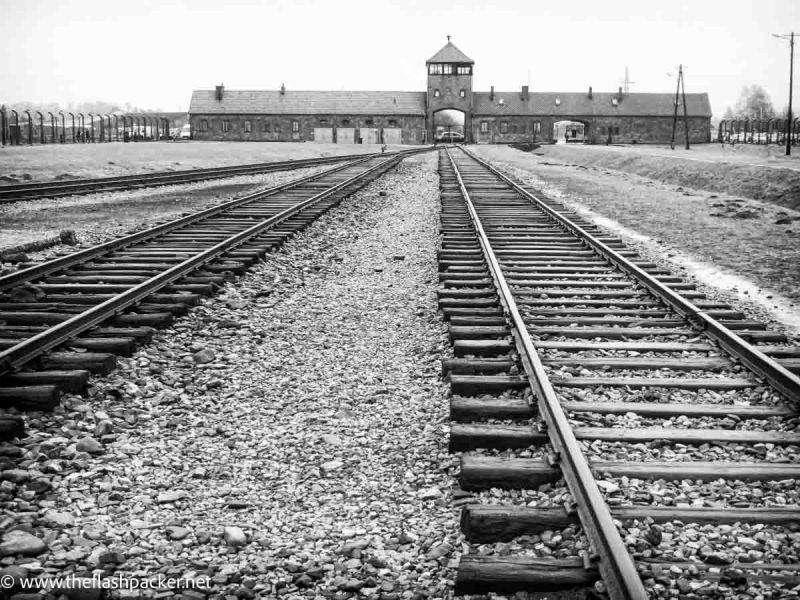
Only those deemed to be useful – invariably the young and fit – avoided the gas chamber. Their ‘reward’ was a sentence of forced labour and existence in appalling conditions.
It was at the unloading ramp that dreams began to die. Dreams of a new home. Dreams of a new life. Dreams of meeting children and grandchildren yet to be born.
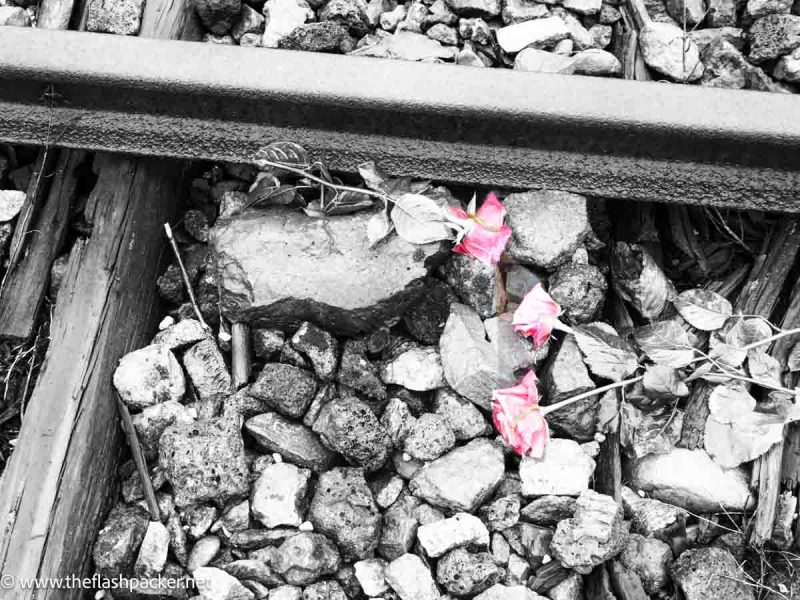
How to get between Auschwitz I and Auschwitz II – Birkenau
If you don’t fancy walking the 3km between Auschwitz I and Auschwitz II – Birkenau, there is a free shuttle bus that runs every 30 minutes.
How to Get from Kraków to Auschwitz
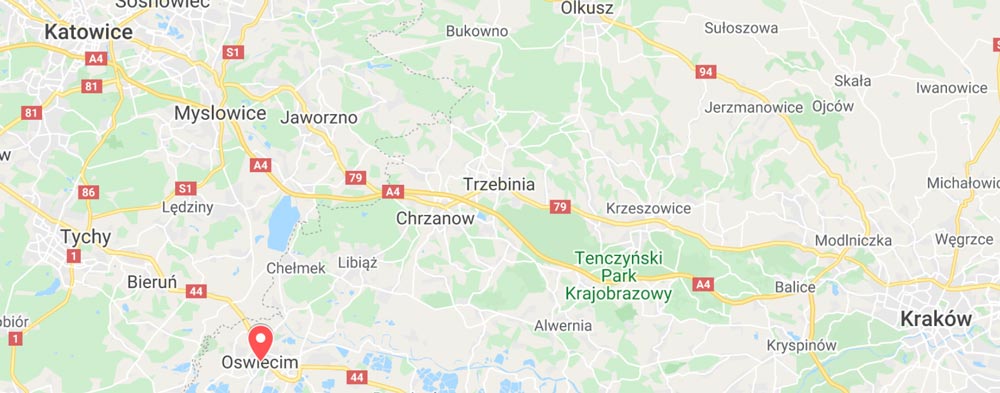
Auschwitz is located in Oświęcim, 66km west of Kraków and 35km southeast of Katowice.
Most people visit Auschwitz as a day trip from Kraków. You can make your own way from Kraków to Auschwitz on public transport, join an organised day excursion or book a transfer.
By bus: the cheapest way to get to Auschwitz
From the main bus station in Kraków (Dworzec Autobusowy), there are direct bus services between Kraków and Auschwitz each day.
The journey takes from 90 minutes to 2 hours. They depart from Kraków’s bus station and cost 5 Euro (December 2023 price).
Buses from Kraków arrive at Oswiecim’s Museum Auschwitz bus stop.
By train: the most reliable way to get to Auschwitz
Frequent trains run between Kraków and Oświęcim. The fastest journey time is 90 minutes.
Although slightly cheaper than the bus, the train is less convenient. The railway station is located between Auschwitz I and Auschwitz II – Birkenau. It will take you 25-30 minutes to walk to Auschwitz I.
On an organised tour: the most convenient way to get to Auschwitz
I joined a tour group in Kraków which was the right decision for me. It was convenient and the guide was excellent, providing far more context than I could have gleaned from a guidebook.
However, the downside was that it sometimes felt rushed and didn’t offer the chance for quiet reflection.
Most of the tour operators in Kraków offer Auschwitz as a day trip. You can also combine Auschwitz and the Wieliczka Salt Mines into one day trip. This is useful if you are short on time but it will be a long day.
I used GetYourGuide to identify day tours to Auschwitz. In my experience, they are reliable, offer a good selection of tours and you can cancel up to 24 hours before your excursion for a full refund.
Here are a few day tours to consider:
AUSCHWITZ-BIRKENAU GUIDED TOUR WITH TRANSPORT
I took this excellent excursion which included transport in a minibus from Kraków, entrance fees and a guide.
>>> BOOK YOUR TOUR HERE
VISIT AUSCHWITZ & WIELICZSKA SALT MINE IN ONE DAY
This full-day guided tour allows you to explore two of Poland’s most popular destinations in one day: Auschwitz-Birkenau and the Wieliczka Salt Mine. It’s also fantastic value.
>>> BOOK YOUR TOUR HERE
On a private transfer: the most comfortable way to get to Auschwitz
One of the disadvantages of day tours is that you are picked up at a pre-determined time that might not be convenient. If you prefer to select the transfer time that best suits your schedule, choose a private taxi service.
After the private transfer from your hotel, you will join a group tour of Auschwitz-Birkenau.
>>> CLICK HERE TO BOOK YOUR PRIVATE TRANSFER
READ THIS NEXT: Top 10 Auschwitz Tours from Kraków
How to Get from Katowice to Auschwitz
It is also possible to visit Auschwitz on a day trip from Katowice.
Infrequent direct trains leave from Katowice’s central station bound for Oświęcim. The fastest journey time is 50 minutes.
You will need to make your way to Auschwitz I on foot or by local bus to start your visit.
Although on the pricey side, a more convenient way to visit Auschwitz from Katowice is on an organised tour. Check the options here.
Buying Tickets
If you are not visiting Auschwitz on a guided tour, you will need to book your Auschwitz ticket in advance through the Auschwitz Memorial website. Tickets for Auschwitz-Birkenau are released 90 days in advance.
There are two types of entry tickets: a guided tour (general tour) or a general admission ticket (tour without an educator).
Guided tours of Auschwitz-Birkenau
The duration of guided tours of Auschwitz-Birkenau is 2.5 – 3.5 hours. However, the shorter duration tour is available only when the opening hours of the Auschwitz Museum do not allow booking a 3.5-hour tour.
Longer study tours are also available.
Visiting Auschwitz-Birkenau without a guide
General admission tickets are available only in the latter half of the day. Their availability is further limited in the summer months when self-guided tours are prohibited between 10 am and 5 pm.
Entry is free but you must book a ticket in advance.
Rules for Visiting Auschwitz
Unsurprisingly, there are several rules for visiting Auschwitz which are listed on the museum’s website.
Many of these are in place to ensure the safety of all visitors and that they “behave with due solemnity and respect.” This includes appropriate dress.
Mobile phone conversations are prohibited in the exhibition buildings and the silence zone in the courtyard of Block 11. Eating, drinking and smoking, including e-cigarettes, is prohibited.
Tips for Visiting Auschwitz
Eating & drinking:
There are a few limited options at the entrance to Auschwitz I
Clothes and footwear
Show respect for the location and dress appropriately. It can be bitterly cold in the winter, so wrap up warm.
As there will be a lot of walking over uneven ground – I clocked up 5 km on my visit – wear comfortable shoes. If it has been raining, it can also be muddy in places.
Bags
There are strictly enforced restrictions on the size of bag you can bring into Auschwitz I (30 x 20 x 10cm). Lockers are available.
Visiting Auschwitz with children
Whilst there are no rules regarding age on a tour of Auschwitz, it’s recommended that those under the age of 14 should not visit.
Visiting Auschwitz: Frequently Asked Questions
What should I do if Auschwitz-Birkenau is fully booked for my dates of travel?
If there are no tickets available, I recommend checking guided tour options with GetYourGuide..
How much time do you need in Auschwitz?
Most guided tours of Auschwitz take 3.5 hours. If you are visiting Auschwitz without a guide, allow at least 90 minutes to visit Auschwitz I and a further 60-90 minutes for Auschwitz II – Birkenau.
Can you take photos inside Auschwitz?
With the exception of two locations – the exhibit of the hair of victims and the basement of Block 11 – photography is permitted throughout the camp. However, tripods and flashes should not be used.
But please be respectful. This should be a selfie-free zone.
Drone photography is prohibited..
I am visiting Auschwitz as part of a visit to Kraków. Do you have any suggestions for what to do in Kraków?
I sure do! Check out this walking tour of Kraków’s Royal Road and my bumper article on how to spend four days in Kraków.
If you are thinking of celebrating the festive season in this lovely city, discover why you should spend Christmas in Kraków.
Should You Visit Auschwitz?
Auschwitz is not only a place to remember and honour the victims of the Nazis’ genocide.
Its buildings silently stand as witnesses to the atrocities that took place there between 1941 and 1944, a warning to humans not to repeat the horrors of the past. Sadly, more recent genocides suggest that humankind is not fully capable of learning these lessons.
I have seen the statistics and visited Yad Vashem in Jerusalem. I have read more than one book on and the subject, seen more than one film.
But it wasn’t until I visited Auschwitz that I could fully appreciate and understand the scale of these atrocities. Somehow it made the horror of the Holocaust more real, more visceral.
Ultimately, a visit to Auschwitz is a profoundly moving experience.
Documentary images of those who perished stare out at you, frozen at that moment in time. Their collected belongings – pots and pans, suitcases, footwear, combs and brushes, tins of hair pomade – declare their belief that they were moving to a different life.
However, the most moving moment came right at the end of my visit.
As we were exiting Auschwitz II – Birkenau, we passed a group of young Israeli visitors. To the haunting strains of John Williams’ theme from the film Schindler’s List, they wordlessly entered the camp, arms wrapped around each other in collective grief and solidarity.
Not for the first time that day, I fought back tears.

About Bridget
Bridget Coleman has been a passionate traveller for more than 30 years. She has visited 70+ countries, most as a solo traveller.
Articles on this site reflect her first-hand experiences.
To get in touch, email her at hello@theflashpacker.net or follow her on social media.
